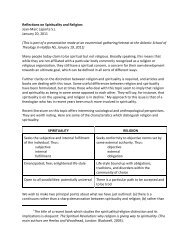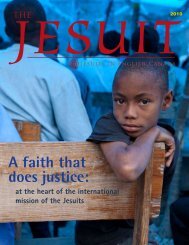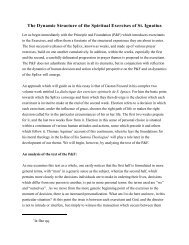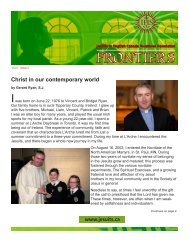Understanding the spiritual journey: from the classical tradition to the ...
Understanding the spiritual journey: from the classical tradition to the ...
Understanding the spiritual journey: from the classical tradition to the ...
You also want an ePaper? Increase the reach of your titles
YUMPU automatically turns print PDFs into web optimized ePapers that Google loves.
3.1.4 To transform what is confirmed: The fourth week of <strong>the</strong> exercises moves exercitants <strong>to</strong><strong>the</strong> o<strong>the</strong>r side of <strong>the</strong> paschal mystery, and <strong>the</strong>y are invited <strong>to</strong> share <strong>the</strong> Christ’s joy in rising<strong>from</strong> <strong>the</strong> dead, and <strong>to</strong> contemplate him as he exercises <strong>the</strong> role of consoler. The choice <strong>the</strong>yhave made and confirmed is transformed by <strong>the</strong> dynamic of <strong>the</strong> resurrection, in which Christconsoles his disciples, transforms <strong>the</strong>m by giving <strong>the</strong>m his Spirit of love, and missions <strong>the</strong>m <strong>to</strong>bring consolation <strong>to</strong> one ano<strong>the</strong>r and <strong>to</strong> all those <strong>the</strong>y serve. This transformation is enhancedin <strong>the</strong> contemplation for obtaining love which immediately follows upon <strong>the</strong> fourth week andis intimately connected with it. Our chosen state of life, ministry, form of service istransformed in that we recognize that ultimately it is not us who act, but Christ. He is present,acting, even <strong>to</strong>iling in all those who with him are builders of God’s reign.3.2 The Four Weeks and <strong>the</strong> Three Ways: is <strong>the</strong>re a way of linking <strong>the</strong> three <strong>classical</strong> waysand <strong>the</strong> four weeks of his SpExx? This <strong>the</strong>oretical question did not loom large for Ignatius. Hequickly connected first week and purgation, second week and illumination. One might surmisethat <strong>the</strong> third and fourth week <strong>to</strong>ge<strong>the</strong>r constitute <strong>the</strong> phase of union, or that illuminationcontinues in<strong>to</strong> <strong>the</strong> third week. But <strong>the</strong>re is ano<strong>the</strong>r way, more symmetrical and more holistic,of understanding this link. It is suggested by Gas<strong>to</strong>n Fessard in his Dialectique des exercisesspirituels de S. Ignace de Loyola. 20 It is presented in <strong>the</strong> diagram. You will note in <strong>the</strong> <strong>to</strong>p par<strong>to</strong>f <strong>the</strong> diagram that <strong>the</strong> purgative phase includes <strong>the</strong> first and second weeks, <strong>the</strong> illuminative<strong>the</strong> second and third weeks, and <strong>the</strong> unitive <strong>the</strong> third and <strong>the</strong> fourth weeks. There is noexplicit evidence of Ignatius having seen things in this way, but this approach fits our readingof <strong>the</strong> text within <strong>the</strong> <strong>tradition</strong>. The move <strong>from</strong> purgative through illuminative <strong>to</strong> unitive ismore complex and gradual than suggested by three cut-and-dry stages, and this approachallows for greater detail. It shows us how gradual is <strong>the</strong> move <strong>from</strong> what <strong>the</strong> purgative at <strong>the</strong>beginning <strong>to</strong> <strong>the</strong> unitive at <strong>the</strong> end. The second half of <strong>the</strong> diagram offers more detail on howeach of <strong>the</strong> three ways can be divided in<strong>to</strong> two parts and how <strong>the</strong> link takes place. 213.2.1 The purgative phase begins with <strong>the</strong> conversion of <strong>the</strong> heart, in which exercitantsexamine <strong>the</strong>ir conscience, acknowledge <strong>the</strong> grave disorders that burden <strong>the</strong>m, and seekforgiveness <strong>from</strong> God, in such a way that while <strong>the</strong>y always remain sinners, <strong>the</strong>y are nowacutely conscious of being forgiven sinners, ready <strong>to</strong> respond <strong>to</strong> whatever God wants of <strong>the</strong>m.This is <strong>the</strong> work of <strong>the</strong> first week. But <strong>the</strong>n in <strong>the</strong> second week this conversion of <strong>the</strong> heartexpands <strong>to</strong> <strong>the</strong> psyche and continues as <strong>the</strong> person enters in<strong>to</strong> contact with <strong>the</strong> earthly lifeand ministry of Jesus and finds <strong>the</strong> courage <strong>to</strong> struggle against all <strong>the</strong> various manifestationsand incitations of sin that remain within him or her. Thus purgation continues in <strong>the</strong> second20 I will use Fessard’s structure but fill in with my own content. I would note that <strong>the</strong> same tacticof providing overlaps is used by Richard of St. Vic<strong>to</strong>r, for example in his treatise on contemplation, TheMystical Ark.21 The two parts of purgation and of illumination are suggested by Richard of St. Vic<strong>to</strong>r’s Edict ofAlexander. The two parts of union are less clear in that work, but <strong>the</strong> movement <strong>from</strong> third degree <strong>to</strong>fourth degree of violent love is very helpful.










